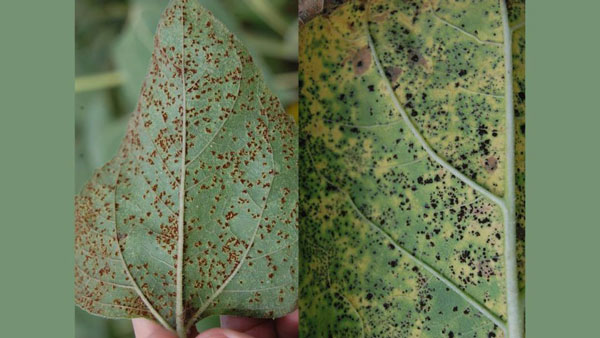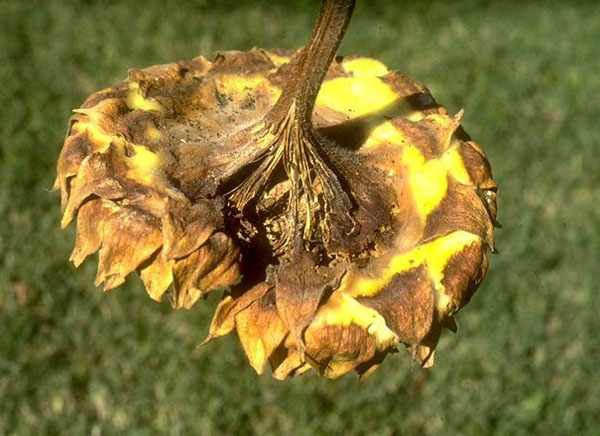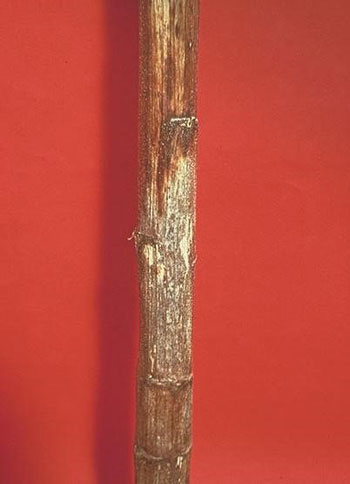When thinking about pest management in sunflowers, weed control and insect management are often the first thoughts. While these are important pests, it is important to not overlook disease management. Managing diseases can increase yields and standability of the crop at harvest. Here is an overview of common yield-limiting diseases of sunflower in Kansas.
Red Rust
Red rust is one of the most important diseases of sunflower in Kansas. In the Sunflower Survey, which is conducted by the National Sunflower Association, 83% of surveyed sunflower fields in Kansas were infested by red rust by the end of the growing season. In this survey, over 100 fields were scouted from 2005 to 2019, across central and western Kansas. Many of these infections were at low levels, but higher infection levels were found in 10% of fields by the R-8 stage of growth (back of the sunflower head is yellow).
This disease is favored by high relative humidity, long periods of leaf wetness, and temperatures between 55 and 85 F. Early disease onset may contribute to severe yield losses if conditions are favorable. Small, raised, cinnamon-colored pustules will appear on the lower surface of the leaf (Figure 1) and will darken in color as disease develops. Under severe disease pressure, defoliation may occur.

Figure 1. Sunflower red rust disease symptoms. Photo: Doug Jardine, K-State Emeritus Extension Plant Pathologist.
Early scouting is key for successful red rust control. Red rust management decisions happen between growth stages R3 (immature bud is elongated about 1 inch from nearest leaf) and R6 (flowering is complete and ray flowers are wilting). Fungicide application is recommended when the average disease severity reaches 1% on the upper four leaves before the R6 stage of development is reached. More resistance is available in oil hybrids than in confectionary hybrids. Additionally, it is important to control both wild and volunteer sunflowers, avoid high nitrogen rates, and avoid high plant populations.
Click here for more information on “Stages of Sunflower Development”.
Rhizopus Head Rot
Rhizopus head rot, another important sunflower disease in Kansas, causes brown, rotted, and stringy lesions on the back of the head (Figure 2). Gray, fuzzy, fungal growth may be found inside the rotted head. Rhizopus was found in 30% of the sunflower fields scouted in the Sunflower Survey since 2005.

Figure 2. Rhizopus head rot disease symptoms. Photo: Doug Jardine, K-State Emeritus Extension Plant Pathologist.
Injuries to the head caused by hail, birds, or insects can increase Rhizopus head rot infection severity. This disease may cause premature death of the head resulting in head drop, which can lead to 100% yield loss. No fungicides are currently available for control of this disease. Studies have shown that management of sunflower head moth is important in decreasing infection and yield loss because head damage caused by larval feeding is an important entry point for the Rhizopus fungus.
Charcoal Rot
A third important disease to be on the lookout for is charcoal rot. Charcoal rot is major dryland problem across several crops in Kansas including soybeans, corn, and grain sorghum. In sunflower production, this disease is mostly a problem during the hottest, driest years. This disease may cause poor grain fill, premature death, and lodging (Figure 3).

Figure 3. Charcoal rot in sunflower. Photo: Doug Jardine, K-State Emeritus Extension Plant Pathologist.
Charcoal rot management requires the adoption of practices that reduce drought stress such as lower plant populations, efficient weed and insect control, irrigation, and reduced tillage.
Helpful Resources
A “Sunflower Production Guide” (A1995), Kandel et al. 2020, was just updated and published by our colleagues at North Dakota State University. You can download a copy of this resource here: https://bit.ly/2KGCj1e
For Kansas, a resource that covers all aspects of sunflower production is the “High Plains Sunflower Production Handbook”. This is publication contains photos of sunflower growth stages, weeds, and diseases. You can download it at https://bit.ly/3c0TgPe . You can also pick up a printed copy at your local K-State Extension Office.
Need Help with a Sunflower Problem?
Contact your local K-State Extension Office. They will work with you to send photos of the problem (close-up, whole plant, field shot) and plant samples to the K-State Plant Disease Diagnostic Lab. Here are guidelines that can help get a good sample to the lab:
Use this link for the sample submission form:
https://www.plantpath.k-state.edu/extension/diagnostic-lab/documents/DiseaseLabChecksheet.pdf
- Fill out the accompanying Plant Diagnostic Lab Form (PDF) as completely as possible.
- Send a plentiful amount of fresh plant material (including roots), it is best to include the entire plant when possible. Shake off most of the soil.
- Send a sample characteristic of the problem that exhibits a range of symptoms.
- Dig (do not pull) up the plant, so the roots remain intact.
- Do not add water or wet paper towels to the sample!
- Seal the plant material in an appropriately sized plastic bag and pack in a crush-proof container.
- Put the accompanying information sheet in a separate plastic bag to keep it dry.
- Bring your sample to the local K-State Extension Office for shipping or you can ship it overnight or early in the week.
Shipping address:
K-State Plant Disease Diagnostic Lab
4032 Throckmorton PSC
1712 Claflin Road
Manhattan, KS 66506
Contact information for K-State Plant Disease Diagnostic Lab:
clinic@ksu.edu
785-532-1383
Rodrigo Onofre, Plant Pathologist
onofre@ksu.edu
Jeanne Falk Jones, Multi-County Agronomy Specialist
jfalkjones@ksu.edu
Doug Jardine, Emeritus Extension Plant Pathologist
Tags: sunflower disease management